THE POSTAL HISTORY OF THE CHANNEL ISLANDS

Prior to the establishment of the Post Office in Jersey and Guernsey and the provision of a regular mail packet service to the islands in 1794, letters to and from the Islands were usually handled by an agent, usually at Southampton (see below), but occasionally Portsmouth or Weymouth and on rare occasions other South Coast ports.

The letter forwarding agent handed the letters onto the captain of a ship that was sailing to either Jersey or Guernsey and upon arrival in the Islands the captain would hand the letters over to another agent based in the Islands for onward transmission. The fee for this service was usually 3d; 1d each for the two agents and 1d for the ship′s captain.

Jersey′s first postal marking came into use in 1794 and remained in use until 1799. This had the word JERSEY arranged in a concave curve (type J1). In 1797 a straight-line JERSEY (type J2) was used concurrently and continued to be used until 1810 by which time the loop of the J had all but disappeared (type J3).

Like Jersey, Guernsey too used a concave curved GUERNSEY hand stamp in use from 1794 (G1). Type 1 of G1 was 46mm wide and used 1794-1803. Type 2 was 49mm wide and used 1802-07 and the type 3 concave curve was 37mm wide and used from 1807-10. By 1810 these hand stamps were replaced by the iconic scroll-type hand stamp. Two types of this hand stamp were used; at first the words JERSEY and GUERNSEY had a dot after the wording (J2 and G2 respectively). The second type of scroll has the words JERSEY and GUERNSEY but the dot had been removed (J3 and G3).
The establishment of the Post Office in the Channel Islands brought with it the same procedures that were uniform throughout the United Kingdom. In the case of letters carried by private ships, it meant that these letters would be subject to the standard ship letter charges, at rates that were higher than the standard Post Office packet mail. The setting up of the Ship Letter Office in London in 1799 saw the introduction of SHIP LETTER hand stamps. Jersey and Guernsey were not exempt from the use of these hand stamps. However, there was considerable opposition to the imposition of the ship letter charges within the Channel Islands, and people felt it was an “outrageous procedure”. Consequently most of the mail was not handed over to the Post Office but delivered by other private means, thus accounting for the lack of use of these hand stamps on incoming mail and hence their great rarity, with only one or two examples existing of some types.
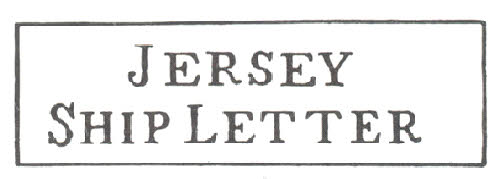
Similarly, mail between the Channel Islands and France is of interest to some Channel Islands specialists who study the French ports of entry for Channel Islands mail, postal conventions and postal rates, and the shipborne Boîte Mobile mail service.
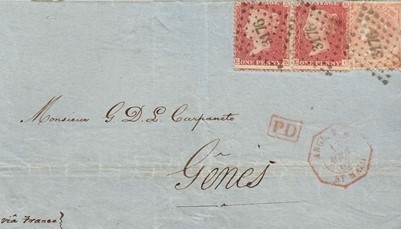
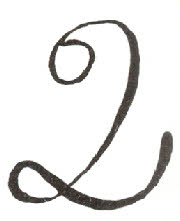

Prior to the introduction of postage stamps, first issued on 6th May 1840, postal charges were usually indicated on the letter in manuscript. However, several Post Offices, including Jersey and Guernsey, produced their own hand struck numerals. These numerals consisted of the numbers ′1′, for the standard 1d. pre-paid letter rate, ′2′ for the unpaid 2d. letter rate and ′8′ indicating the 8d. postage due for unpaid ship letter charges.
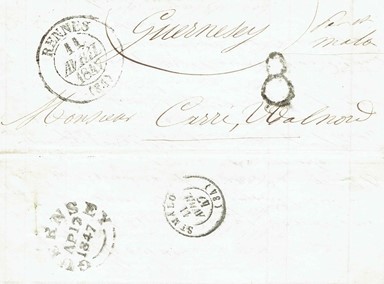
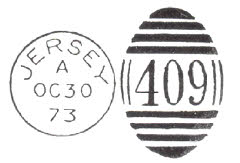
1840 also saw the introduction of the Maltese Cross handstamp throughout the Great Britain postal system and both islands were issued with their own version of the standard Maltese Cross, which remained in use until 1844 when the numeral obliterators came into use. Jersey received number “409” and Guernsey “324”. Literature also mentions the famous Alderney Maltese Cross. However, there is no clear evidence that this particular hand stamp was ever used in the Channel Islands, especially on Alderney, and it is thought that it was used for a period of time in the London Ship Letter Office.
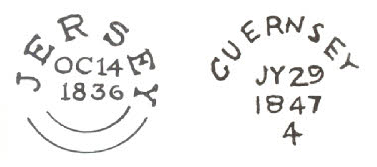
The use of datestamps on mail within the Channel Islands started on 31st May 1830 when the “Improved Steel Datestamp” was introduced to both Jersey and Guernsey. Various versions lasted in use until 1845, and then, having been re-cut, were used again until 1847 in Guernsey and 1849 in Jersey. From time to time these steel datestamps became damaged and the so-called “travelling” or “skeleton” hand stamp was used as a temporary replacement. These hand stamps were made up locally on a skeleton frame that had moveable letters. It is recorded that Jersey used a travelling hand stamp during 1843, 1845 and 1847 (types J34, J34a and J35) whilst Guernsey used the travelling hand stamp twice, in 1843 and 1847 (type G21 and type G22). All are scarce.
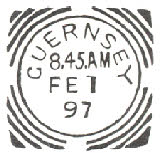
The mid-1800s saw many changes in the type of hand stamps used and they remain a source of interest for the postal historian. These hand stamps include the double arc type, early single circle, also known as “thimbles”, squared circles, double circles and modern single circles. In 1923, mechanisation of the postal service saw the introduction of the first machine cancellations, a Krag type, and this was replaced by the Universal cancellation machine in 1930.
From a Postal History point of view, the Channel Islands are interesting during the World War II period. Please refer to the Occupation Page for further information.
Specialists in Channel Islands postal history may also be drawn to the slogans used on today’s mail. However, the first slogan used on Channel Islands mail was the Jersey “The Best Investment a Telephone” in 1931. Also cachets applied to mail will be of interest to the postal historian, for example the two MAIL PER SS IBEX cachets (J16 and J17) applied to the small amount of mail salvaged from the SS Ibex when she struck rocks off Jersey in January 1900.
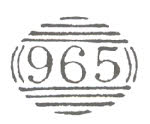
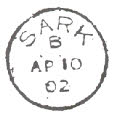
The smaller Channel Islands also have interesting periods of postal history. The establishment of the post office on Alderney in 1848 saw the London G.P.O. dispatch an undated double arc hand stamp and a “965” numeral obliterator, both rare on mail from Alderney. Another scarce item from Alderney is the single circle 20mm ALDERNEY (code A or B) used 1860-71. The post office was not established on Sark until 1858 and, like Alderney, Sark also has a scarce undated double arc hand stamp. Also rare is the 29mm single circle SARK date stamp used during 1888. There is also some interesting postal history related to the smaller islands of Jethou, Brecqhou and Lihou which are listed in the Channel Islands’ Postal History catalogues issued by Stanley Gibbons.
The postal history of the Channel Islands is a fascinating topic for further study, and it is hoped that these brief notes will encourage more collectors to specialise in this field of philately.
